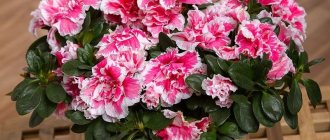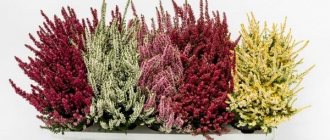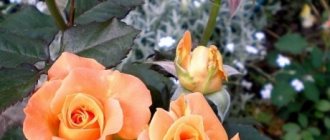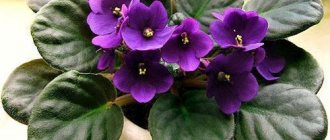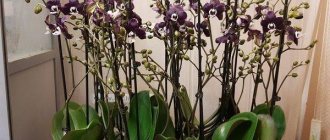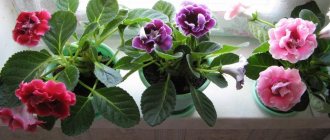Description
Azalea Mix belongs to the genus Rhododendron of the Ericaceae family. The plant is low, about 60 cm. A shrub with succulent dark green leaves. The leaves are round, pointed, oblong, the leaf surface is dense and smooth. The flowers are small and resemble a bouquet of roses. With proper care, lush flowering.
Flower color varies from pink to white. The crown shape is dome-shaped, consisting of several flowers. The root is small and flat. Azalea is very popular among gardeners and is called indoor rhododendron. Translated, rhododendron means tree with roses or rose tree.
History of origin
Azalea Mix is a hybrid rhododendron. The birthplace of natural varieties is India, China, and Japan. At the beginning of the 20th century, breeders developed indoor Mix azaleas. Wild azalea is found in the Himalayas. At the end of the 18th century it was brought to Europe. Breeders have created more than 12 varieties of this plant.
What is the difference from other types of rhododendron?
Unlike natural varieties, Mixes have a weak aroma or no smell at all.
The main difference between an azalea flower and other types of rhododendron is the number of stamens. The number of stamens coincides with the number of petals and does not exceed five.
Rhododendrons have two per petal, while other varieties have more than 10. Otherwise, it is impossible to distinguish azalea from other types of rhododendron.
Pros and cons of this growing method
Azalea is a rather capricious plant that is demanding in terms of growing conditions and care. This process has both its pros and cons. Let's start with the pros:
Miniature trees turn out to be very beautiful, neat in shape. Bright flower caps will decorate any windowsill, garden or flower bed.- In this way, you can grow azaleas with different flowering periods and admire them for almost six months or more.
- With proper care, a formed tree will delight you with its flowering for many years.
- Azalea on a trunk can be grown in bonsai style. This trend is fashionable and popular among flower growers.
The disadvantages of this method of growing include:
- There is some complexity in the process, which lies in the timely and correct pruning of the bush.
- Azalea's capriciousness regarding conditions and care.
- Quite a long process of tree formation. As a rule, the plant is formed over several seasons.
Subsorts with photos
Simsa
Azalea Simsi or Indian azalea is an evergreen plant native to China. Simsi bushes are branched, elliptical leaves, cup-shaped flowers, varied colors, flowering from November to May with proper care. The root is flat.
Dwarf
Dwarf rhododendron, 50–60 cm in height, is an evergreen bush with a dense crown. The stems are numerous and twining. The leaves are small, dark green, oblong in shape and grow alternately. The leaf blade is covered with scales or hairs. The flowers are bell-shaped or cup-shaped and not very large. Inflorescences are collected in 2 - 3 flowers, densely planted. A wide variety of colors: pink, lemon, dark red. The root is flat.
What kind of soil is needed?
The plant needs loose soil with good aeration and moisture permeability. The soil should be acidic (pH 3.5-5).
It is better for beginning flower growers to use special soil purchased in the store, this could be “Terra Vita”, “Azalea”, “Fasco”, “Garden of Miracles”, “World of Soils”, Rich Land.
You can prepare the soil mixture yourself by mixing:
- 2 parts of coniferous land;
- 2 parts leaf soil;
- 1 part peat;
- 1 part heather soil;
- 1 part river sand.
Before use, the earth mixture must be calcined, frozen or spilled with a solution of potassium permanganate - this will help get rid of pests and microorganisms.
Bloom
When and how does this process occur?
Indoor azaleas bloom during the colder months of the year, usually in winter. The flowering period depends on comfortable conditions. Flowering lasts from two weeks to three months. If your flower drops its petals after 2 weeks and stops blooming, then you need to pay attention to the conditions under which it is kept.
Azalea needs light and moisture from the soil and air. Spray and water with cool water.
The main factor is a cool temperature of no higher than 18 degrees. It is better to leave azaleas outside until it gets cold, and then keep them on the balcony until it gets cold.
Care before and after
During flowering, much attention is paid to fertilizer:
- It is recommended to use Zircon once a week. It stimulates flowering and growth of the root system.
- Epin is needed for spraying once every 2 weeks. Can only be used before the buds open.
During flowering, bright light is required, but not direct sunlight, but diffused light.
Regular watering is required, the soil should be moist but not wet. Soft water is used. It must settle, it must be filtered or softened by freezing in the refrigerator. You need to spray carefully, do not get it on the flowers , otherwise they will rot and fall off.
Azalea blooms once a year, but if you create ideal conditions, it will bloom again after a few months. After flowering, as soon as the flowers fall, it is recommended to prune and replant the plant.
Pruning is required. If this is not done, the bush will become loose, and the stems will stretch and droop.
What to do if it doesn't bloom?
If the azalea does not bloom, then you need to take a closer look at the contents of the plant. There are many reasons:
- high temperature, i.e. hot air from batteries;
- direct sunlight;
- lack of lighting, daylight hours – 10-12 hours;
- south side of the room;
- watering with warm water or water with lime;
- drying out of the earth;
- untimely pruning;
- drafts
It is important to pinch and prune the crop correctly, which will give abundant and long-lasting flowering.
How to trim an azalea (video)
The beautifully flowering indoor azalea is popular among domestic amateur gardeners due to its attractiveness and wide selection of varieties. However, the plant is not unpretentious, so to obtain abundant and long-lasting flowering, you will need to spend a lot of time and effort, providing the ornamental crop with competent and complete care at all stages of development.
Azalea is an evergreen shrub with beautiful, pubescent leaves on both sides. The flowers are mostly single-colored - white, scarlet, purple, but there are also more interestingly colored varieties. There are both indoor and garden varieties.
Care after purchase: step-by-step instructions
Selecting a location
Rhododendrons need good lighting. The most suitable place is partial shade, where the bush will not receive direct sunlight and it will not fade. But it is not advisable to plant in deep shade, otherwise you will wait a long time for flowering.
If the plant is indoors, then the best place is a windowsill that faces west, east or north. In winter, it is advisable to use additional lighting - fluorescent lamps.
What should the soil be like?
Acidic soils rich in humus are suitable for rhododendron.
You can prepare the mixture yourself, for this you need:
- Peat.
- Sand.
- Coniferous land.
The ratio is one to one and then everything is mixed.
Heather soil is also suitable. If it is not possible to find it, then you can replace it with a soil mixture:
- Peat soil (1 part).
- Coniferous (2 parts).
- River sand.
It is desirable that the soil is loose and not caking and can easily allow water to pass through. Therefore, they also add perlite. If you can’t make the soil yourself, then the best option is to buy it at a flower shop, where all the necessary substances and microelements are added to the composition.
Planting, including standard planting
- Azalea Mix is formed on a trunk; for this purpose, a strong cutting is selected.
- The side branches are pruned and the cuts are treated with garden varnish.
- When caring for the trunk, the pot must be periodically rotated 180 degrees.
- During growth, you should monitor the branches - the supports of the tree's crown - so that they are at the same level.
- For planting, the transshipment method is used. To do this, you need to soak the substrate of the planting flower. It is necessary to lay a 5 cm layer of drainage at the bottom of the pot. The seedling along with the earthen ball is carefully lowered and covered with the prepared substrate. A pot 10-15 cm high is suitable for planting azaleas.
A clay container is required to circulate air in the soil.
Temperature
Another important factor in caring for blooming azaleas is temperature. The suitable temperature for azaleas is 10 - 15 degrees; a cool room is required.
If it is not possible to create such a temperature at home, then it is better to keep the indoor flower on a closed loggia, but so that the temperature does not drop to 5 degrees Celsius. If left at home, the maximum temperature should not be higher than 18 degrees. You can also spray the bush with distilled water several times a day.
Watering
If it is hot and sunny, then the azalea needs to be watered a couple of times a day. It is advisable to spray several times a day, but use only distilled water. It is also necessary to periodically water it with a solution of citric acid.
Stagnation of moisture in the pot is not advisable, as this can lead to rotting of the crop.
Top dressing
Feeding plays an important role; the plant needs to be especially fed during the flowering period. You can use mineral supplements. You can use superphosphate, especially when the flower is in bud. You can use Zircon, its advantage is that it is based on plant materials. For 20 liters of water you will need only 1-2 drops of the product.
Trimming
Pruning is of great importance. It should be pruned only after flowering. The crown is formed by pinching the shoots. If this method is not used, the plant will grow and there will be significantly fewer flower buds.
Transfer
Frequent replanting is not advisable. Replanting is done no more than once a year if the bush is under 3 years old. Transplantation is necessary when:
- rotting of the substrate;
- flower diseases affecting the roots;
- and with strong root growth.
Under no circumstances should you replant an azalea during budding or flowering. She will immediately drop her buds and may even die.
It is strictly not recommended to replant azaleas in winter.
Types and varieties of azaleas
Azalea on a trunk is a perennial ornamental plant, indoor and garden type. Outwardly it resembles a tree, which is achieved through pruning. The article will tell you about the characteristics of different types and varieties of plants, care rules and possible difficulties.
There are two main types found in home gardening.
Indian azalea (Rhododendron simsii)
Indoors it is small in size, ranging from 40-60 cm. In open soil it can reach 1.5 m or more. The species is characterized by heterogeneity in flowering times, shape, and color in different varieties. The flowers of this species are larger and are often variegated, double or smooth. A characteristic feature is the fact that yellow or orange coloring is rare among Simson's rhododendrons, and purple or blue coloring of the corollas is completely absent.
Japanese azalea (Rhododendron obfusum)
Indoors does not exceed 60 cm in height. Often, as it grows, it becomes shaped like a dense pillow. The size is relatively small, but this disadvantage is compensated by the abundance of flowering. Easily tolerates temperature fluctuations and pruning. That is why the standard tree, trimmed to resemble bonsai trees, is gaining popularity.
Modern breeders have developed many new varieties, but the most common are those listed below.
Azalea japonica Melina
It is distinguished by its bright carmine coloring and beautiful curved edges of the petals. It blooms profusely, the buds almost completely cover the leaves. It is distinguished by its small size - at the age of ten years it rarely exceeds 30 cm in height.
Japanese azalea Kermesina Alba
Snow-white buds are small in size, almost completely densely covering the branches; Azalea “Knap Hill Sylphides” is a deciduous, frost-resistant variety. Can withstand temperatures down to -32C. The flowers are light pink at the corollas, with a bright yellow spot in the center. The shape resembles a funnel. The average height of the bush does not exceed 1.2 m.
Azalea Rhododendron Golden Lights
An unusually cold-resistant plant that can grow up to 150 cm. The buds are full, golden yellow, up to 7 cm in diameter.
Azalea hybrid Azurro
They are distinguished by large flowers of bright purple color with crimson dots on the inside of the corolla. The bushes grow up to 150 cm.
Hybrid azalea Rhododendron Golden Eagle
A cold-resistant deciduous plant that can reach a height of 1.8 m. The crown is wide, spherical in shape. The petals are semi-double, yellow and orange in color, reach 6 cm in diameter, collected in inflorescences of 6-12 pieces.
Deciduous Jolie Madame
One of the tallest bushes. At ten years it can grow up to 3 m. The flowers are simple and large. The color is pink, with a small orange spot in the center. One shoot can have 7-9 buds.
Deciduous Knap Hill Schneegold
In open ground it can grow up to 2 meters in height. The flowers are large, wavy along the edges, white with a yellow spot on the corolla and a pinkish tint along the edge.
Selection does not stand still and every year more and more different hybrids appear. Thanks to this, every gardener can choose a variety that will meet all aesthetic and biological requirements.
How to propagate?
There are several methods of reproduction, such as:
- using seeds;
- cuttings;
- vaccination;
- dividing the bushes (as a rule, an old plant with a large number of shoots is used).
Breeding azaleas using seeds is not effective; this method is rarely used. A more effective method is to propagate azaleas using cuttings. The process consists of several stages:
- Choice of cuttings. The cuttings should be 5-7 months old. Remove the buds, leave 3-4 leaves at the top. The length of the cutting is 6-7 cm.
- Preparing the cuttings. Treat with a non-concentrated solution of potassium permanganate.
- Preparing the landing site. Pebbles are laid out at the bottom of the container and soil on top. Water the soil well before planting.
- Landing in the ground. Plant 3-4 pieces in a pot, planted in abundantly watered soil at a distance of 4-5 cm from each other. Planting depth 2-3 cm.
- Creating conditions for growth. Cover the cuttings with film, moisten the soil from time to time and ventilate the cuttings daily. Such breeding is labor-intensive, but produces significant results.
Azalea propagation
Azaleas are propagated by cuttings. Let’s say right away that this is not for the lazy; there will be long and painstaking work ahead.
- In the spring we cut shoots 7-9 cm long, pinched last year in July, after pruning.
- We cut off the 3 lower leaves, leave the length of the cutting equal to 0.5 cm, and cut the remaining leaves in half.
- We make an oblique cut from below, just under the bud.
We should not forget that we take cuttings only from healthy, well-developed plants and no more than once a year.
Before planting, we tie the cuttings into a bundle of 10-20 pieces. We immerse the prepared bunch in a container with a solution of heteroauxin (indoleacetic acid - growth stimulator) - (2 tablets per 1 liter of water) with the lower cut for 6 hours. Then we transplant it into the prepared greenhouse to a depth of 2 - 3 cm. We put 2 - 3 cm of gravel on the bottom of the greenhouse, then 3 cm of sifted coarse sand (without stones), and on top we fill the substrate - a mixture of coniferous soil and peat, cover the entire greenhouse with film , spraying periodically.
We plant the cuttings according to the 4x4 cm pattern.
At a greenhouse temperature of 25 degrees and a relative humidity of 80%, your cuttings will form a strong root system in 2 months. The temperature in the greenhouse should not be allowed below +22 degrees. From time to time you need to rotate the greenhouse so that all plants are illuminated evenly.
If possible, install a heating device in the greenhouse with an automatic system for maintaining the temperature within 25-27 degrees.
Reproduction of azaleas by cuttings is possible only from mid-July to mid-October. We ventilate the cuttings a week after planting in the morning for an hour, avoiding drafts, then cover them again with film. As soon as the cuttings give roots and shoots begin to grow, we remove the film and begin daily spraying and watering our babies with melted, boiled or distilled water so that the soil is moist all the time.
As soon as the young shoots reach two to three centimeters, we transplant the cuttings into pots or a greenhouse filled with 10-12 centimeters of coniferous substrate. According to the 10x10 cm scheme. 2-3 months after transplantation, the tops of the cuttings are pinched to form a bush and young shoots. We remove the first buds from the plant for better growth of new shoots. After 3 months, we pinch it a second time and cut off 4 to 6 new shoots. We transplant young shoots into new pots filled with substrate. It is better to take the pot size about 10 cm. The entire process of growing cuttings lasts about 2 - 3 years.
Dividing the bush
Only adult healthy plants 3-4 years old are divided. They act carefully, trying not to damage the delicate root system. The first time after planting, the plants are given enhanced care.
Seed propagation is not used at home due to its complexity and labor intensity. This method is used by professionals and breeders. If you decide to try to grow azalea from seeds, sow with a reserve. At best, only half of the seeds will sprout. Germination requires sunlight, warmth, and acidic soil. Young seedlings are weak - the slightest drying out or waterlogging of the soil will destroy them.
By layering
Azaleas can be propagated by layering
- To do this, bend the lower branches to the ground and pin them with paper clips or hairpins. Cover with soil and wait until the branches give independent roots.
- The process is quite long, rooting will not occur earlier than in six months. Only after this the branches are detached from the parent plant.
Diseases and pests
By appearance, you can determine azalea diseases, such as:
- Curling the ends.
- The appearance of spots on the leaves.
- Yellowing or rotting of the root system.
- The leaves are falling off.
Leaves fall off - reason:
- The plant is in the wind.
- Preparing for winter in deciduous varieties.
- Low room temperature.
- Aphid.
- Spider mite.
If you have an azalea in your home, then many questions immediately arise about caring for this plant. How to grow an Indica variety and make a bonsai from a regular one - read on our Internet portal.
Azalea Indica home care
If you follow all the care conditions, the azalea will reward you with lush, beautiful flowering.
Temperature indicators
The plant loves cooler air. The optimal indicators are numbers from +100 C to +150 C. If in winter such conditions are easy to create, then in summer everything is much more difficult. Many gardeners move the flowerpot to a cool room or dig it into the soil. In this case, it is worth covering the container to prevent insects from getting inside. To do this, a nylon stocking is pulled over the flowerpot.
In autumn, it is recommended to take the flower out onto the loggia or into an unheated room. This will help the plant to lay a large number of buds, which will delight you with bright colors closer to spring.
Irrigation and air humidity
Azalea is a flower that loves moist soil. Therefore, in order for the bush to be beautiful and develop well, you need to constantly monitor the condition of the soil. The plant should be watered only with settled liquid without any impurities.
Azalea does not tolerate stagnation of liquid.
During the cold season, it is recommended to reduce the number of procedures by half and completely stop spraying.
The water that has collected in the pan must be constantly poured out. This will help prevent rotting of the root system. It is recommended to acidify the liquid once a month. To do this, use citric or oxalic acid. Add it at the rate of 0.3 g per 1 liter of clean water, room temperature.
Pruning and pinching bushes
This procedure is mandatory, as it increases the intensity of azalea flowering. The first procedure is carried out in May immediately after flowering. At the same time, all weak, limp and deformed branches are cut off.
If you do not prune and pinch, then after some time the bushes will become looser and the flowers smaller.
During the summer period, all young shoots need to be pinched, and elongated shoots should be trimmed. Each branch should have 4-5 leaves.
It is also mandatory to pinch the shoots that appear near the flower axils. If everything is done correctly, then new branches will appear in 2-3 weeks.
Diseases and pests
The plant is quite resistant to disease, but if you violate the rules of care, the leaves can be attacked by various insects. Most often, scale insects, flower moths, whiteflies, mealybugs, and aphids are observed on azaleas. Spider mites and thrips also feed on Indica leaves.
Prevention of various problems
Basic recommendations for flower care:
- good lighting, but without direct sunlight;
- fertilizing, especially during flowering;
- do not place the plant in drafts;
- water with distilled water;
- spray frequently;
- maintain a certain temperature.
Azalea Mix is a very beautiful flower that requires some attention. In order for the development of this species to proceed correctly, certain conditions are needed. The reason for the lack of flowering may be:
- incorrect soil composition;
- fungal diseases;
- mites;
- thrips and other pests.
If you find an error, please select a piece of text and press Ctrl+Enter.
Features of growing azaleas on a trunk
Azalea on a trunk is distinguished by the presence of an axial trunk, which should be located perpendicular to the ground.
To form you need:
If desired, after the trunk (trunk) is formed, you can experiment with the crown and give it the shape of a ball.
In addition to caring for the appearance of rhododendron, do not forget about other features:
- Lighting is an important factor in the life of rhododendron. A rather capricious plant does not tolerate direct sunlight. In summer it is better to place it in shaded areas. It is diffused light that is best received;
- Replanting - it is better to replant young ones every year, and more mature ones once every two to three years. It is better to replant using the transshipment method (transfer to a new substrate without clearing the soil from the roots). This will help keep the root system intact. It is recommended to use shallow pots as containers;
- Watering and humidity indicators - if the pot is placed indoors, it is recommended to maintain high humidity in the room. To do this, it must be watered and sprayed every morning. You can only use rainwater or water that has had time to settle. By autumn, the amount of watering and frequency of spraying should be reduced, but with the beginning of the heating season, increase again;
- Substrate – The ideal soil for this beauty is acidic soil. Grows well in hydroponics, heather soil, a mixture of coniferous and peat soil;
- Temperature – the most suitable temperature for growing is considered to be 14-20C;
- Fertilizers. In spring and summer - potassium sulfate, ammonium sulfate, ammonium nitrate. In winter and autumn - superphosphate at the rate of 15 g per 10 liters of water.
Planting/growing
The flower can grow both at home and in the wild. In the second case, the habitat of the culture is moist forests. Similar conditions need to be created at home. To obtain the required level of moisture, you should regularly spray the soil and use a humidifier. Experienced flower growers advise placing a container of water near the Azalea - this will help increase the area of evaporation. Spraying is necessary in summer.
The crop can also be grown in a flower bed in the garden. The main thing to remember is that Azalea standard care at home requires more careful care.
Recommendations for choosing a plant
You can buy azalea on a standard at any flower shop. Both adult plants and seedlings are offered for sale. Prices for flowers with a height of 15 cm to 20 cm start from 500 rubles.
When purchasing, first of all, pay attention to:
- On the soil in the pot - it should be moist;
- The leaves should not fall off after a slight shaking;
- The color of the leaves should be uniform, and the plates should not be damaged;
- Size – it is better to choose medium. Big ones can have a hard time adapting to new conditions, while small ones simply cannot bear the change of environment.
After purchase, it is recommended to replant the rhododendron along with the earthen ball. A few days after transplanting, moisten the soil with a solution of Fundazol.
A whimsical, but incredibly beautiful plant, it is difficult to adapt to a change in environment, so when choosing, you should focus on strong, medium-sized flowers.
